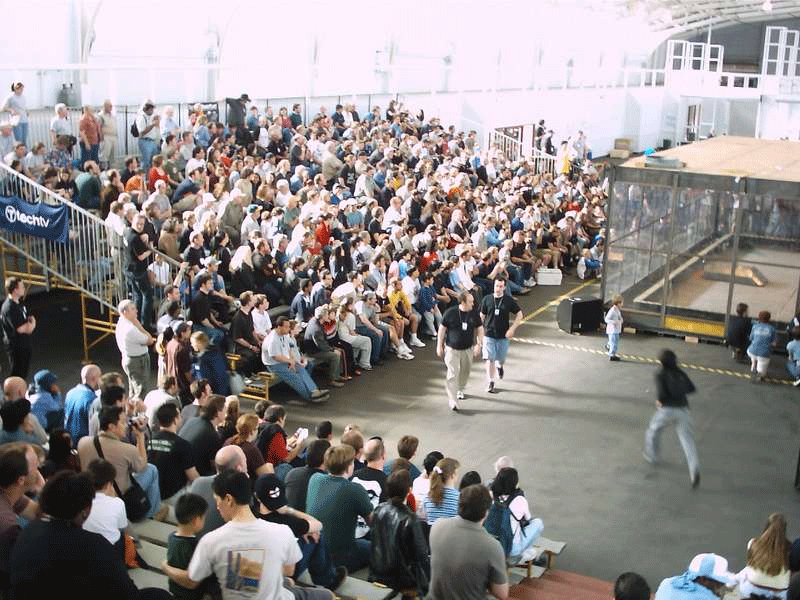 Click to Enlarge
Click to Enlarge
San Francisco — The hundreds of youngsters who hooted and cheered as
combat machines ruthlessly bashed each other at the RoboGames
competition here last month showed how entertaining robots can be. But
as the robots grappled, their limitations were also evident, revealing
the distance they may have to travel before finding a killer app.
While the weekend event demonstrated the mechanical strength and
dexterity, as well as human-like problem solving of new-generation
robots, many competitors were students and hobbyists without large
corporate sponsorships.
The RoboGames included robotic sumo wrestlers, maze runners and
autonomous land vehicles, biped androids that could imitate the action
of human joints in motion, and even Sony's soccer-playing Aibo robotic
dogs. In one event, autonomous fire-fighting robots had to enter a
facsimile of a burning building, distinguish between a light bulb and a
candle (both sources of heat and light) and pour water on the right
one.
The games drew 214 teams from 13
countries, according to David Calkins, president of the Robotics
Society of America, its principal sponsor. There were 466 robots,
backed by some 646 engineers. Segments of the destructive combat
sequences were shown on local television and on CNN.
One participant saw the robots' potential for military applications.
Bob Bluhm, general manager for the portable oscilloscope unit of
Tektronix Inc., a sponsor of the CM Robotics team, said he is
enthralled with the life-saving potential of robots. "These things are
moving from the factory floor" — where they can lift a car body and
position a welding torch to within a fraction of an inch — "to
battlefield situations," where they dismantle bombs and extract bullets
from wounded solders, Bluhm said.
The Defense Advanced Research Projects Agency (Darpa) has funded a
number of robotics research projects in hopes of finding military and
aerospace applications, Bluhm said. The most visible to date is the
Darpa Grand Challenge, in which teams race autonomous vehicles across
the Mojave Desert.
"Look at the multiple electronics systems these units must employ,"
Bluhm said. "You need complex vision systems, motors and servos,
needles and pincers with micro-inch precision. On top of that, it needs
to be battery-powered and energy-efficient."
"Robotics brings a convergence of three different technologies
— electronics, electromechanics and precision machining," explained
Calkins, who is also a professor of Robotics and Computer Engineering
at the School of Engineering at San Francisco State University, where
the RoboGames were held. "The sumo robots are good sensors," he said.
"The androids are good electromechanical implementations; the combat
guys are good machinists."
The sound and the fury
While robots can demonstrate intelligence, manual dexterity and
mechanical strength, there were few contests at the RoboGames that
actually called for equal measures of all three. The combat machines
brought to mind Shakespeare's conjecture that all the world's a stage.
The microprocessor intelligence in the machinery had little to do with
who won or lost: Victory had more to do with power in the motor wheels
and transmissions.
The sound and the fury: Victory often had more to do with brute strength than with machine intelligence.
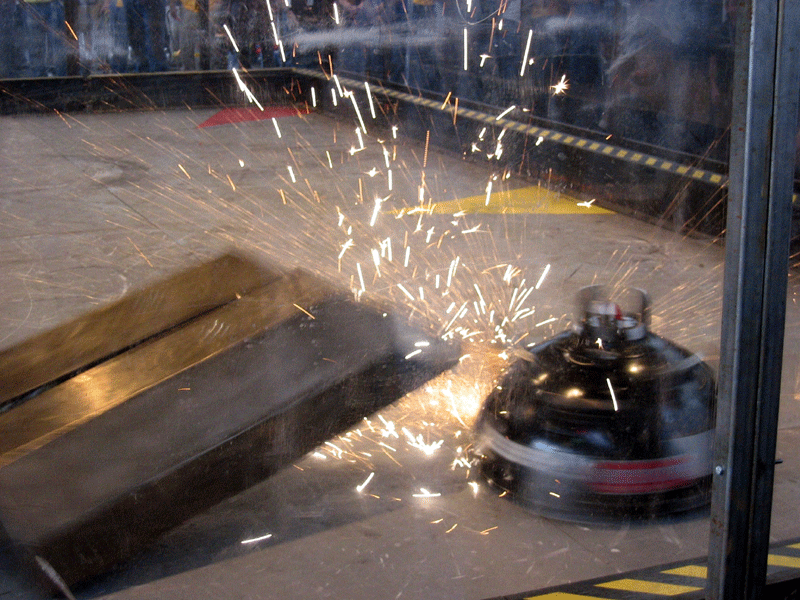 Click to Enlarge
Click to Enlarge
One type of combat robot was a low-to-the-ground steel platform that
could scoop underneath its competitor, drive it against the steel
girders that served as the railings of the combat ring and ultimately
toss it out of the ring. Another combat machine was a "spinner," a
barbed or bladed spinning top that could literally slice pieces out of
its opponent. A 340-pound spinner, called Super Megabyte, ultimately
won the heavyweight combat.
One spinner, developed by CM Robotics (San Jose, Calif.),
employed an infrared pulse in its navigational mechanism. The same
wheels that spun the barbed weapon also propelled it by controlling
each wheel's direction, speed and torque. Rotary encoders on the wheels
provided almost instantaneous feedback on their direction and speed.
Waiting for combat: There is palpable tension as the CM Robotics
team awaits their turn in the robot gladiator arena. Michael Worry
(dark shirt. far right), CEO of design services company Nuvation checks
the range finder on his computer.
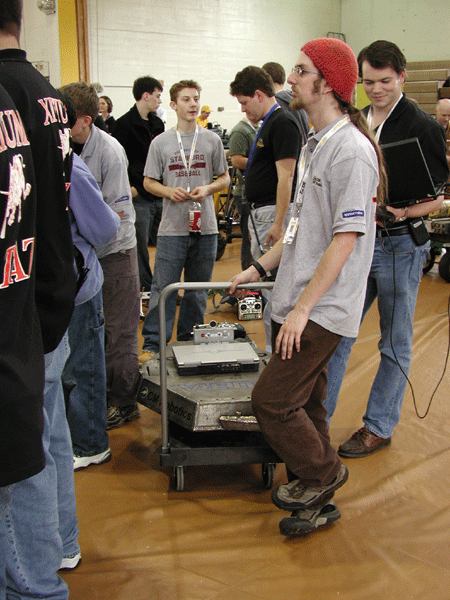
 Click to Enlarge
Click to Enlarge
Altera Corp., another sponsor of the CM Robotics team, provided the
Cyclone FPGAs and Nios operating system used in the robot's unique
propulsion system, said Michael Worry, CEO of Nuvation Research Corp.,
the engineering services group that programmed the FPGAs. Tektronix
provided the TPS2000 portable scope used to calibrate the infrared
navigational pulses, Worry said.
The same wheels that spun CM Robotics' barbed weapon also propelled it by controlling each wheel's direction, speed and torque
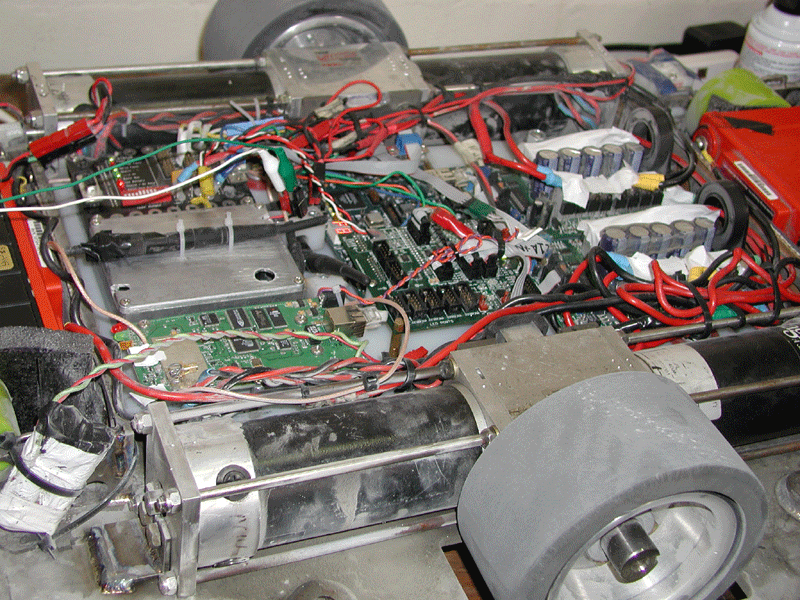 Click to Enlarge
Click to Enlarge
The events that required the most robotic intelligence also required a
lot of patience to sit through. The soccer-playing Sony Aibo is built
with a MIPS R6000 processor, 64 Mbytes of main memory and firmware
(compiled from C++) inserted through a USB Memory Stick. Despite the
color recognition on which the event hinged, no DSPs or sophisticated
pattern-matching mechanisms were employed in the Aibos.
Rather, a soccer-playing Aibo could recognize color-coded goal areas
and an orange ball with a CMOS image sensor. It would lunge at the
orange ball and attempt to score by swatting it toward the goal area
with its snout. But some of the robot players acted like "goalies" on
the field, lying down flat with their front legs around the ball as if
they were going to lick it. Then they refused to move. The humans
performed a "hard reset" by lifting the confused robot doggie out of
the green-mat playing field, visually orienting it on a border and
putting it back.
Aibo plays soccer: In one of the competitions at the RoboGames,
teams of Sony robot dogs were programmed to drive a ball towards an
opponents goal and swat it in with their snouts.
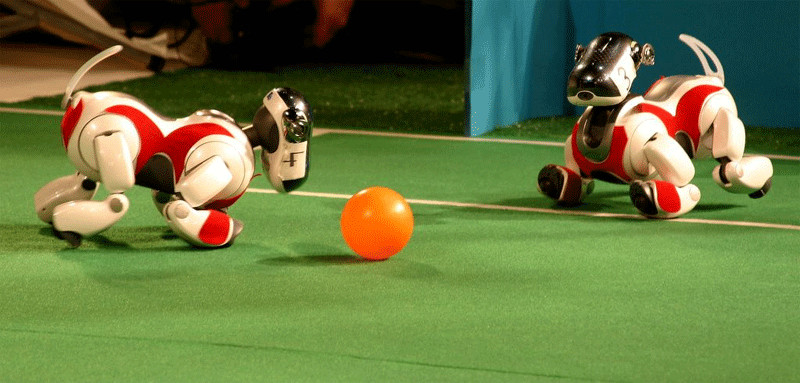 Click to Enlarge
Click to Enlarge
The Aibo soccer match was won by a team from Dortmund University in Germany, the Hellhounds, sponsored by Microsoft Corp.
Robomagellan (like the Darpa Challenge) was a competition emphasizing
autonomous navigation between two objects — orange traffic cones —
about a half-mile down steps, then onto a lawn and around trees, on the
grounds of San Francisco State. The timed event tested obstacle
avoidance over a varied, outdoor terrain.
"Xploradora," a self-propelled, self-directing machine constructed by
hobbyists Brandon Blodget and James Ogden seemed to have gone further
than any of its competitors, in the second round of competition — about
half way between the cones — before it came to a dead stop. "The
battery gave out," said Blodget, who happens to be a staff engineer
with Xilinx's Research Labs in San Jose.
Third place winners: Hobbyists James Ogden and Brandon Blodget
(right) won a bronze medal in the Robo-Magellon competition at the
RoboGames.
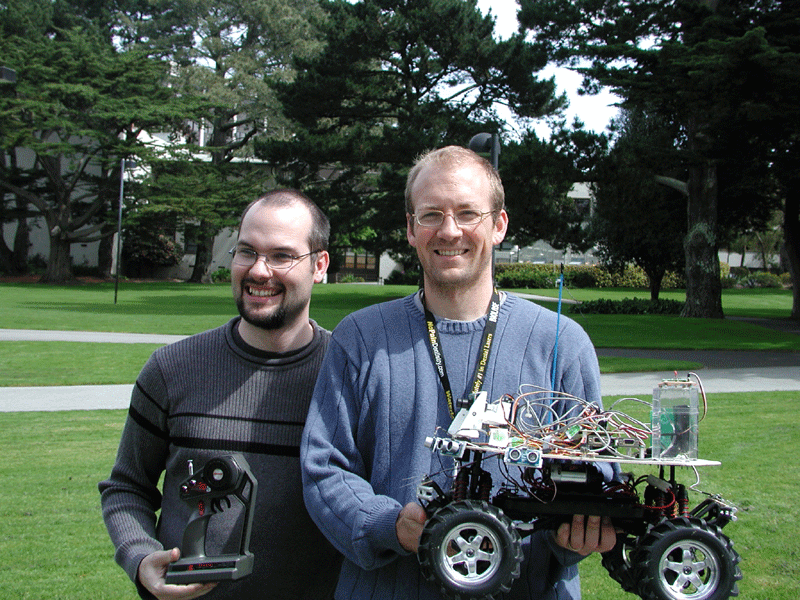 Click to Enlarge
Click to Enlarge
While on-board image sensors helped Xploradora steer clear of objects,
Blodget had hoped that a GPS position finder would help the robot
navigate. In the end, he had to rely on the resolution of the robot's
internal compass, and FPGAs to hardwire his instructions — "go 20 feet
and turn left," etc. — in hopes that it would advance the progress of
his machine in the following round. While it was forbidden to
communicate with the machine while it navigated its course, a Bluetooth
link allowed Blodget to download fresh instructions and to debug
between the second and third rounds of competition. His machine
ultimately won third prize, a bronze metal, in the contest.
"The technology development is probably between that of an
Apple I and an Apple II," Calkins said, acknowledging the "garage shop"
feel of many of the robot entries. "Sony and Honda have built brilliant
walkers," he said, referring to the biped androids that emulate human
movements. "These guys [contestants in the games] build them in their
garages for one or two thousand dollars."
"Robotics won't take over the world," Calkins concluded. "It will just
enhance living." He sees robotics not as an all-embracing movement but
as a proliferation of special-purpose machines, like autonomous vacuum
cleaners and lawn mowers. "Our job is to inspire and educate," he said.
|